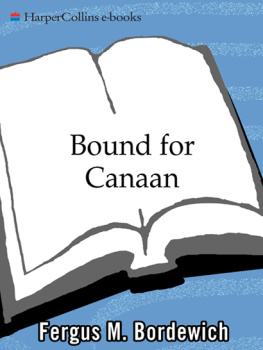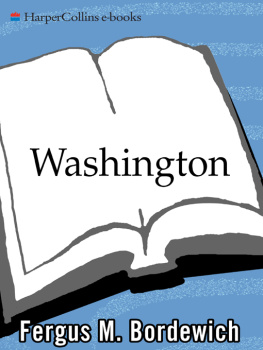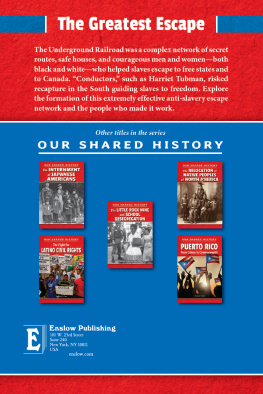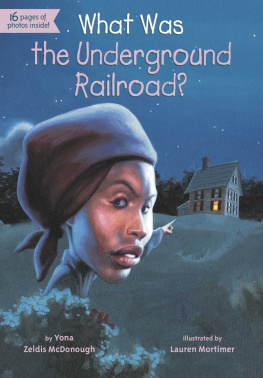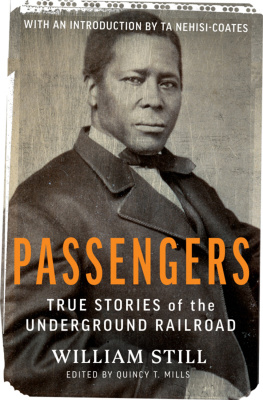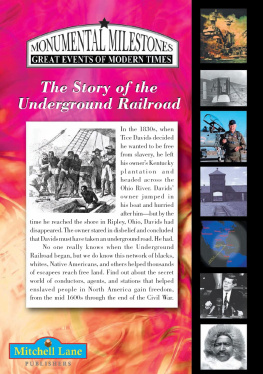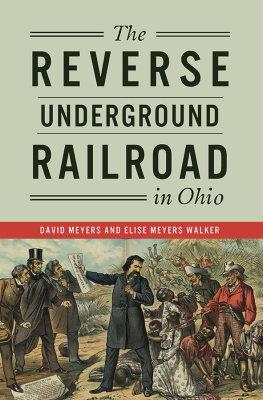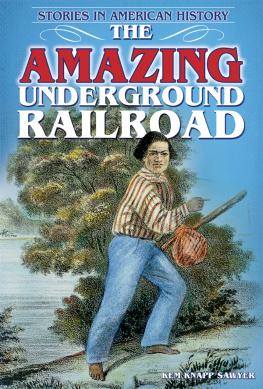FERGUS M. BORDEWICH
The E PIC S TORY of the U NDERGROUND R AILROAD, A MERICAS F IRST CIVIL R IGHTS M OVEMENT
This book is dedicated to the countless thousands of men and women who fled the bonds of slavery but were recaptured or died at the hands of their pursuers before they reached the safe embrace of the Underground Railroad. They are not forgotten.
Many people have contributed to this book, in large ways and small, and have helped to make Bound for Canaan better than it would otherwise have been. I am especially indebted to Christopher Densmore, curator of the Friends Historical Library of Swarthmore College; David Levering Lewis; Kate Clifford Larson; Milton C. Sernett of Syracuse University; Jill Jonnes; and Stanley Harrold of South Carolina State University at Orangeburg. They were unfailingly generous with their time and insights during the writing of Bound for Canaan, and offered many valuable suggestions. Judith Wellmans knowledge of the underground in upstate New York was a resource upon which I drew many times. As always, Jack Barschis provocative questions prompted me to rethink and clarify more than a few half-rendered ideas. What flaws remain are of course my own.
In many parts of the country, historians and local researchers generously shared the wealth of Underground Railroad lore they have collected. Diane Perrine Coon unraveled for me the intricate web of underground activity around Madison, Indiana. Betty Campbell was a rich source of information about the abolitionists of Ripley, Ohio. Caroline Miller explained the interwoven worlds of slavery and abolitionism in Bracken County, Kentucky. Randy Mills and Les and Mark Coomer were my guides in southwestern Indiana, an exceptionally interesting area for the study of the Underground Railroad. John Creighton led me expertly through Harriet Tubman country on the Eastern Shore of Maryland. Paul and Mary Liz Stewart made the Albany, New York, underground come alive. Steve Collins took me to the poignant site that was once the town of Quindaro and filled my ears with stories of the underground in eastern Kansas. George Nagle of the Afrolumens Project, Tracey Weis and Leroy Hopkins of Millersville State College, and Matthew Pinsker of Dickinson College helped me to understand the underground in south-central Pennsylvania. Jane Williamson, curator of the Rokeby Museum, in Ferrisburgh, Vermont, introduced me to the marvelous world of the Robinson family.
Bryan Prince, curator of the Buxton National Historic Site, in Ontario, was one of the first historians I interviewed in 1998, before Bound for Canaan was even a proposal. He spent another long and productive session with me in 2003, discussing the remarkable story of Reverend William King and the Elgin Settlement. Also in Canada, Gwen Robinson, director of the WISH Centre, in Chatham, was a bottomless mine of information on the fugitive community there, and on John Browns activities north of the border. John MacLeod of the Fort Malden National Historic Site, and Elise Harding-Davis, curator of the North American Black Historical Museum, provided very useful background on the black community and the British military garrison at Amherstburg. Steven Cook, supervisor of the Uncle Toms Cabin Site near Dresden, directed me toward material on Josiah Hensons life in Canada. Wilma Morrison of the Norval Johnson Heritage Library welcomed me graciously in Niagara Falls.
In Canada, my dear friend David Lipton of Toronto contributed his time, a historians rigor, and best of all his company as a traveling companion. The Canadian sections of Bound for Canaan were sharpened and deepened thanks to him.
Many librarians lightened the weight of my work by adding their own expertise to my research. Among them were Alison Gibson of the Union Township Library, in Ripley, Ohio; Thomas D. Hamm, curator of the Friends Historical Collection at Earlham College; David Poremba, manager of the Burton Historical Collection of the Detroit Public Library; Arden Phair, curator of collections at the St. Catharines Museum; and Judith Sweets of the Watkins County Museum, in Lawrence, Kansas. Elizabeth Moger; Walker Goller of Xavier University, in Cincinnati; Jae Breitweiser, director of the Eleutherian College Historic Site, in Lancaster, Indiana; Saundra Jackson, director of the Levi Coffin House Museum, in Fountain City, Indiana; Tom Calarco of Schenectady, New York; Mary Dugan of Kennett Square, Pennsylvania; James A. McGowan, and Steve Strimer of Northampton, Massachusetts, also lent assistance or advice at important points in my research.
My mother-in-law, Marjorie Allen Parvin, first introduced me years ago to the fascinating history of the North Carolina Quakers. Barbara Wright; her mother, Marietta Wright; and Hal Sieber directed me to sources of material on the underground there. Gwen Gosney Erickson, archivist of the Friends Historical Collection at Guilford College, made my research on the North Carolina Quaker underground a real pleasure. Richard Parvin, Ed Parvin, and John Parvin provided valuable nautical information that enabled me to describe navigation along the Florida coast.
I owe much to Carl Westmoreland of the National Underground Railroad Freedom Center, who in the course of a days drive along the Ohio River in 1998 convinced me that there was a real need for a new general history of the Underground Railroad. Carls vast knowledge of the underground prompted many lines of inquiry that I would not otherwise have suspected.
Bound for Canaan might never have come into being at all without the unflagging enthusiasm of my literary agent, Elyse Cheney, and my ever-encouraging editor at Amistad Books, Dawn Davis, not to mention the support of my wife, Jean, and the forbearance of my daughter, Chloe, who has perhaps come to think of books as cosmic black holes into which her father periodically disappears.
TO THE PAPERBACK EDITION OF B OUND FOR C ANAAN
T HE U NDERGROUND R AILROAD AND THE S PIRIT OF P LACE
The response to the hardcover edition of Bound for Canaan has been enthusiastic, not only in states where the far-flung lines of the Underground Railroad once operated, but also in the onetime slave states of the border country and the Deep South. In part, no doubt, this reception reflects the simple fact that it is the first national history of the underground to be published in more than a century. It also suggests that increasing numbers of Americans are now willing to look with an unflinching eye at both the history of slavery and the racial and religious radicalism of the men and women of the Underground Railroad, whose exploits were long consigned to the less threatening realm of legend.
As I traveled around the United States, I found scoresand there may well be hundredsof local groups busy identifying and memorializing the safe houses and routes of the Underground Railroad. The National Park Services excellent Freedom Trails program has done much to foster this grassroots movement. But it also reflects, more deeply, the degree to which the story of the Underground Railroad continues to engage our national imagination, and the almost mystical magnetism with which that story is rooted in a sense of place.

